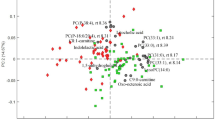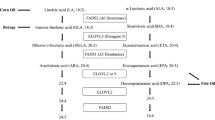Abstract
Purpose
For people with metabolic syndrome (MetS), altering the macronutrient composition of their diets might ameliorate metabolic abnormalities. The common method of clinical assessment only measures total lipid concentrations but ignores the individual species that contribute to these total concentrations. Thus, to predict the amelioration of MetS following caloric restriction (CR) and the intake of fish oil, we used lipidomics to investigate changes in plasma lipids and identify potential lipid metabolites.
Methods
Lipidomics was performed using ultra-high-performance liquid chromatography–tandem mass spectrometry on plasma samples from a clinical trial conducted over 12 weeks. Subjects were randomized into two groups: CR (n = 12) and CR with fish oil (CRF, n = 9). Anthropometric and clinical parameters were measured and correlated with plasma lipidomics data.
Results
Compared with baseline, significant differences were observed in body weight, waist circumference, blood pressure and interleukin-6 in both groups, but triglyceride (TG) levels significantly decreased in only the CRF group (all p < 0.05). A total of 138 lipid species were identified. Levels of species containing long-chain polyunsaturated fatty acids were significantly elevated—greater than twofold—following fish oil intake, these included TG (60:9) and phosphatidylcholine (p40:6) (all q < 0.05). TG (60:9) tended to correlate negatively with body weight, body mass index, blood pressure, and HbA1c following fish oil intake.
Conclusion
CR and fish oil can ameliorate MetS features, including anthropometric parameters, blood pressure, and blood lipid concentrations. The levels of particular lipid species such as TG-containing docosapentaenoic acid were elevated post-intervention and negatively associated with MetS features. TG (60:9) may be proposed as a lipid metabolite to predict amelioration in MetS following the intake of CR and fish oil.




Similar content being viewed by others
Abbreviations
- AA:
-
Arachidonic acid
- ALA:
-
α-Linolenic acid
- CR:
-
Caloric restriction
- DHA:
-
Docosahexaenoic acid
- DPA:
-
Docosapentaenoic acid
- EPA:
-
Eicosapentaenoic acid
- HMDB:
-
Human metabolome database
- LA:
-
Linoleic acid
- MetS:
-
Metabolic syndrome
- PC:
-
Phosphatidylcholine
- PE:
-
Phosphatidylethanolamine
- PL:
-
Phospholipid
- PS:
-
Phosphatidylserine
- PUFA:
-
Polyunsaturated fatty acid
- UPLC:
-
Ultra-performance liquid chromatography
References
Alberti KG, Eckel RH, Grundy SM et al (2009) Harmonizing the metabolic syndrome: a joint interim statement of the international diabetes federation task force on epidemiology and prevention; national heart, lung, and blood institute; American heart association; world heart federation; international atherosclerosis society; and international association for the study of obesity. Circulation 120:1640–1645
Eckel RH, Grundy SM, Zimmet PZ (2005) The metabolic syndrome. Lancet 365:1415–1428
Kaur J (2014) A comprehensive review on metabolic syndrome. Cardiol Res Pract 2014:943162
Consultation WE (2004) Appropriate body-mass index for Asian populations and its implications for policy and intervention strategies. Lancet 363:157–163
Wen CP, David Cheng TY, Tsai SP et al (2009) Are Asians at greater mortality risks for being overweight than Caucasians? Redefining obesity for Asians. Public Health Nutr 12:497–506
Helble M. FK (2017) The imminent obesity crisis in Asia and the Pacific: first cost estimates. ADBI working paper series. Asian Development Bank Institute, Japan
Ramachandran A, Chamukuttan S, Shetty SA, Arun N, Susairaj P (2012) Obesity in Asia—is it different from rest of the world. Diabetes Metab Res Rev 28(Suppl 2):47–51
Lin CC, Liu CS, Lai MM et al (2007) Metabolic syndrome in a Taiwanese metropolitan adult population. BMC Public Health 7:239
Franz MJ, VanWormer JJ, Crain AL et al (2007) Weight-loss outcomes: a systematic review and meta-analysis of weight-loss clinical trials with a minimum 1-year follow-up. J Am Diet Assoc 107:1755–1767
Velazquez-Lopez L, Gonzalez-Figueroa E, Medina-Bravo P et al (2013) Low calorie and carbohydrate diet: to improve the cardiovascular risk indicators in overweight or obese adults with prediabetes. Endocrine 43:593–602
Havel PJ (2002) Control of energy homeostasis and insulin action by adipocyte hormones: leptin, acylation stimulating protein, and adiponectin. Curr Opin Lipidol 13:51–59
Zhang YY, Liu W, Zhao TY, Tian HM (2017) Efficacy of omega-3 polyunsaturated fatty acids supplementation in managing overweight and obesity: a meta-analysis of randomized clinical trials. J Nutr Health Aging 21:187–192
Sanders F, McNally B, Griffin JL (2016) Blood triacylglycerols: a lipidomic window on diet and disease. Biochem Soc Trans 44:638–644
Beger RD, Dunn W, Schmidt MA et al (2016) Metabolomics enables precision medicine: “A White Paper, Community Perspective”. Metabolomics 12:149
Fekete K, Marosvolgyi T, Jakobik V, Decsi T (2009) Methods of assessment of n-3 long-chain polyunsaturated fatty acid status in humans: a systematic review. Am J Clin Nutr 89:2070S–2084S
Yang K, Han X (2016) Lipidomics: techniques, applications, and outcomes related to biomedical sciences. Trends Biochem Sci 41:954–969
Stephenson DJ, Hoeferlin LA, Chalfant CE (2017) Lipidomics in translational research and the clinical significance of lipid-based biomarkers. Transl Res 189:13–29
Holcapek M, Liebisch G, Ekroos K (2018) Lipidomic analysis. Anal Chem 90:4249–4257
Lee H-C, Cheng W-Y, Hsu Y-H et al (2015) Effects of calorie restriction with n-3 long-chain polyunsaturated fatty acids on metabolic syndrome severity in obese subjects: a randomize-controlled trial. J Funct Foods 19:929–940
Chen MS, Chen SH (2018) A data-driven assessment of the metabolic syndrome criteria for adult health management in Taiwan. Int J Environ Res Public Health 16:92
Folch J, Lees M, Sloane Stanley GH (1957) A simple method for the isolation and purification of total lipides from animal tissues. J Biol Chem 226:497–509
Bland JM, Altman DG (1995) Multiple significance tests: the Bonferroni method. BMJ 310:170
Zurlo F, Trevisan C, Vitturi N et al (2019) One-year caloric restriction and 12-week exercise training intervention in obese adults with type 2 diabetes: emphasis on metabolic control and resting metabolic rate. J Endocrinol Invest 42:1497–1507
Razny U, Kiec-Wilk B, Polus A et al (2015) Effect of caloric restriction with or without n-3 polyunsaturated fatty acids on insulin sensitivity in obese subjects: a randomized placebo controlled trial. BBA Clin 4:7–13
Hu T, Mills KT, Yao L et al (2012) Effects of low-carbohydrate diets versus low-fat diets on metabolic risk factors: a meta-analysis of randomized controlled clinical trials. Am J Epidemiol 176(Suppl 7):S44–S54
Munro IA, Garg ML (2013) Dietary supplementation with long chain omega-3 polyunsaturated fatty acids and weight loss in obese adults. Obes Res Clin Pract 7:e173–e181
Shearer GC, Savinova OV, Harris WS (2012) Fish oil—how does it reduce plasma triglycerides? Biochim Biophys Acta 1821:843–851
Stanley EG, Jenkins BJ, Walker CG et al (2017) Lipidomics profiling of human adipose tissue identifies a pattern of lipids associated with fish oil supplementation. J Proteome Res 16:3168–3179
Lankinen M, Schwab U, Erkkila A et al (2009) Fatty fish intake decreases lipids related to inflammation and insulin signaling–a lipidomics approach. PLoS One 4:e5258
Surette ME (2008) The science behind dietary omega-3 fatty acids. CMAJ 178:177–180
Calder PC (2006) n-3 polyunsaturated fatty acids, inflammation, and inflammatory diseases. Am J Clin Nutr 83:1505S–1519S
Nording ML, Yang J, Georgi K et al (2013) Individual variation in lipidomic profiles of healthy subjects in response to omega-3 Fatty acids. PLoS One 8:e76575
Ottestad I, Hassani S, Borge GI et al (2012) Fish oil supplementation alters the plasma lipidomic profile and increases long-chain PUFAs of phospholipids and triglycerides in healthy subjects. PLoS One 7:e42550
Toledo E, Wang DD, Ruiz-Canela M et al (2017) Plasma lipidomic profiles and cardiovascular events in a randomized intervention trial with the Mediterranean diet. Am J Clin Nutr 106:973–983
Rhee EP, Cheng S, Larson MG et al (2011) Lipid profiling identifies a triacylglycerol signature of insulin resistance and improves diabetes prediction in humans. J Clin Invest 121:1402–1411
Dalli J, Colas RA, Serhan CN (2013) Novel n-3 immunoresolvents: structures and actions. Sci Rep 3:1940
Del Gobbo LC, Imamura F, Aslibekyan S et al (2016) Omega-3 polyunsaturated fatty acid biomarkers and coronary heart disease: pooling project of 19 cohort studies. JAMA Intern Med 176:1155–1166
Abbott SK, Else PL, Atkins TA, Hulbert AJ (2012) Fatty acid composition of membrane bilayers: importance of diet polyunsaturated fat balance. Biochim Biophys Acta 1818:1309–1317
Munro IA, Garg ML (2013) Prior supplementation with long chain omega-3 polyunsaturated fatty acids promotes weight loss in obese adults: a double-blinded randomised controlled trial. Food Funct 4:650–658
Helland A, Bratlie M, Hagen IV et al (2017) High intake of fatty fish, but not of lean fish, improved postprandial glucose regulation and increased the n-3 PUFA content in the leucocyte membrane in healthy overweight adults: a randomised trial. Br J Nutr 117:1368–1378
Braverman NE, Moser AB (2012) Functions of plasmalogen lipids in health and disease. Biochim Biophys Acta 1822:1442–1452
Lankinen M, Schwab U, Kolehmainen M et al (2016) A healthy nordic diet alters the plasma lipidomic profile in adults with features of metabolic syndrome in a multicenter randomized dietary intervention. J Nutr 146:662–672
Tonks KT, Coster ACF, Christopher MJ et al (2016) Skeletal muscle and plasma lipidomic signatures of insulin resistance and overweight/obesity in humans. Obesity 24:908–916
Surowiec I, Noordam R, Bennett K et al (2019) Metabolomic and lipidomic assessment of the metabolic syndrome in Dutch middle-aged individuals reveals novel biological signatures separating health and disease. Metabolomics 15:23
Zacek P, Bukowski M, Johnson L, Raatz SK, Picklo M (2018) Selective enrichment of n-3 fatty acids in human plasma lipid motifs following intake of marine fish. J Nutr Biochem 54:57–65
Meikle PJ, Wong G, Barlow CK, Kingwell BA (2014) Lipidomics: potential role in risk prediction and therapeutic monitoring for diabetes and cardiovascular disease. Pharmacol Ther 143:12–23
Acknowledgments
The authors thank all study participants for their cooperation and the staff of Taipei Medical University Hospital and Wan Fan Hospital in Taiwan for their assistance throughout this study. We also thank the staff of the Core Research Facility Center at Taipei Medical University for assistance with UPLC–MS/MS. This study was supported by grants from the Taiwan Ministry of Science and Technology (MOST106-2320-B-038-062-MY3 and MOST106-2314-B-038-049).
Author information
Authors and Affiliations
Contributions
The author’s responsibilities were as follows: AS, H-TW, H-CL and S-YH conducted the study design and performed data analyses. AS, T-HT, and S-YH were responsible for clinical recruitment. AS and T-HT performed plasma lipidomic analyses. AS, NTKN, H-CL and S-YH assisted with the editing of the manuscript. AS, H-CL and S-YH prepared the initial draft and finalized the manuscript. All authors participated in the analytical discussion of the results and approved the final version of the manuscript.
Corresponding author
Ethics declarations
Conflict of interest
No potential conflicts of interest were reported by the authors.
Rights and permissions
About this article
Cite this article
Shabrina, A., Tung, TH., Nguyen, N.T.K. et al. n-3 PUFA and caloric restriction diet alters lipidomic profiles in obese men with metabolic syndrome: a preliminary open study. Eur J Nutr 59, 3103–3112 (2020). https://doi.org/10.1007/s00394-019-02149-4
Received:
Accepted:
Published:
Issue Date:
DOI: https://doi.org/10.1007/s00394-019-02149-4




